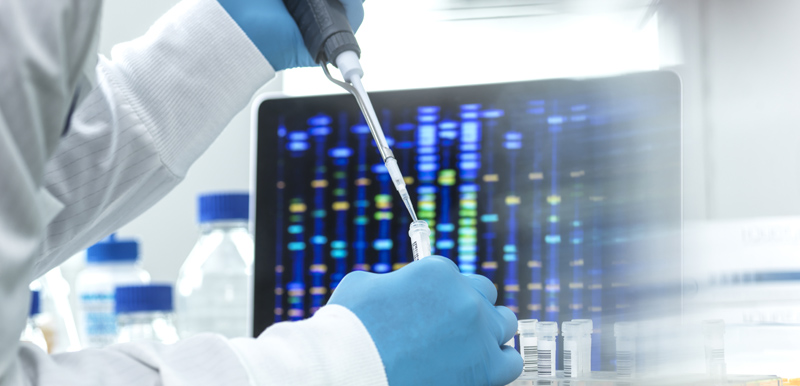DNA testing methods continue to rapidly evolve. Today, not only is DNA testing more popular, but the number of industries that use DNA testing only continues to grow. In this blog, we’ll take you through the history of DNA science, who invented DNA testing, the significant discoveries, current uses, and the possibilities for the future.
Who Invented DNA Testing?
With so many breakthroughs in the field of DNA science, it’s difficult to say who exactly “invented” it. Many respected experts have had their hand in furthering our understanding of how DNA and genetics work and can be analysed.
DNA Fingerprinting
The scientific community credits British geneticist Alec Jeffreys with inventing DNA fingerprinting in 1984. At the time, Jeffreys was working in the genetics department at the University of Leicester. There, he discovered that small sections of DNA, called minisatellites, could be isolated and analysed, creating a unique identifier for each individual. This discovery revolutionised DNA testing and has since been used to solve crimes, establish paternity, and identify victims of war and disaster.
DNA Sequencing
Frederick Sanger is best known for inventing DNA sequencing. His method, known as the Sanger method, is still used today. The Sanger method involves separating a DNA strand into a series of fragments based on their size. After being separated by size, scientists can analyse the fragments and determine the sequence of the DNA.
The Sanger method is a powerful tool that has transformed the DNA world. Scientists have used it to sequence the genomes of thousands of organisms, including humans. The Sanger method has also been used to diagnose diseases and develop new drugs.
Polymerase Chain Reaction (PCR)
Doctor Kary Mullis invented polymerase chain reaction (PCR). PCR works by repeatedly heating and cooling DNA. When DNA is heated, it separates into two single strands. Next, an enzyme called “Taq polymerase” is introduced to the sample. This enzyme synthesises and uses the original DNA strands to “build” two new strands of DNA. Technicians can repeat this process many times, producing millions of copies of the original DNA. PCR is an essential tool. In fact, many COVID-19 tests initially used PCR before rapid testing became readily available.
Current Applications of DNA Testing
DNA testing is a significant tool utilised by many industries. Below are a few of the many applications we can thank DNA testing for.
Forensics
Ever since access to DNA testing became readily available, it has been used by forensics teams and crime scene investigators worldwide. Some of the most infamous criminals have been convicted with the help of DNA testing.
Exonerations
Modern DNA testing can be used to pardon those wrongfully convicted of a crime – especially in cases where DNA science was not available during the original trial. The process is intricate, but organisations work tirelessly to achieve justice.
Paternity Testing
During a paternity test, DNA from the child and the alleged father are analysed, and the properties of the DNA are compared. DNA science is the foundation of paternity testing; without it, getting a paternity test wouldn’t be possible. Today, paternity can be determined even without a sample from the father. By testing close relatives such as a grandparent or another sibling, paternity can be determined with extremely high accuracy when using a reputable provider like DNA Diagnostics Centre.
Ancestry Testing
Rather than analysing old documents, birth certificates, and photos, now you can learn about your lineage through your DNA. With DNA ancestry testing, a professional will compare your DNA to existing autosomal genetic markers, populations, and gene pools.
Early Gender Detection
Early gender detection for your baby is now possible thanks to the ever-advancing field of DNA science. The Peekaboo Early Gender DNA Test uses PCR technology to detect the presence or absence of Y (male) chromosomes from cell-free fetal DNA found in the mother’s blood.
The Future of DNA Science: CRISPR
CRISPR is an acronym for Clustered Regularly Interspaced Short Palindromic Repeats. It is a gene-editing tool that scientists can use to make precise changes to DNA. Though it is still a relatively new technology, CRISPR has the potential to make a major impact. It could revolutionise the way doctors can treat diseases and so much more.
CRISPR works by using a guide RNA to locate a specific DNA sequence. At that point, the Cas9 protein cuts the DNA at that location. The cut in the DNA sequence allows scientists to insert, delete, or replace parts of the DNA. So far, CRISPR has been used to help treat animal diseases, and it is being tested in clinical trials for human diseases. It has also been used to improve crop yields and create new varieties of crops.
The Ethical Dilemma Surrounding CRISPR
CRISPR is a powerful tool that can provide exciting benefits, but it also has the potential to be misused. Those in the field of DNA science must use CRISPR responsibly and ethically.
In 2017, Chinese scientist He Jiankui claimed to use CRISPR to edit the genes of two embryos, resulting in the birth of twin girls who were immune to HIV. Considering he had no permission to do so from the girls’ parents and the Chinese government, he was sentenced to three years in prison.
In 2019, researchers in the United States were accused of secretly using CRISPR to edit the genes of human embryos donated by couples undergoing IVF.
These cases highlight the importance of developing ethical guidelines for using CRISPR.
The Value of DNA Testing
DNA testing is an outstanding triumph of modern science that can provide many benefits. While understanding the science behind DNA testing isn’t always easy, recognising its value is. As time passes, DNA testing will likely continue to become more affordable, accessible, and accurate. The potential for DNA testing to change lives is endless.

